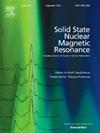A solid-state NMR approach for distinguishing between RNH2 and RNH3+ sites
IF 2.4
3区 化学
Q4 CHEMISTRY, PHYSICAL
引用次数: 0
Abstract
A necessary step in characterizing solid-phase organic materials is the accurate assignment of the ionization state at acidic and basic sites. Solution phase pKa's are not always reliable reference points because local environments can significantly change pKa values in solids. Herein, an approach for distinguishing R–NH2 and R–NH3+ is described based on experimental 15N chemical shift tensors principal values for a given site (i.e. δ11, δ22 and δ33) from 18 model compounds. Those 15N sites that are present as R–NH3+ have anisotropies between 5 and 15 ppm. In contrast, all R–NH2 sites have anisotropies between 14 and 115 ppm. These R–NH2 moieties can be further categorized into three subgroups. The differences observed are postulated to arise from differences in the symmetry of the intermolecular hydrogen bonding environment, or the direct attachment of the NH2 to an aromatic ring.

区分RNH2和RNH3+位点的固态核磁共振方法。
表征固相有机材料的一个必要步骤是准确地确定酸性和碱性位点的电离状态。溶液相pKa并不总是可靠的参考点,因为局部环境可以显著改变固体中的pKa值。本文描述了一种基于实验15N化学位移张量主值(即δ11, δ22和δ33)从18个模型化合物中区分R-NH2和R-NH3 +的方法。这些以R-NH3 +形式存在的15N位点的各向异性在5到15ppm之间。相反,所有的R-NH2位点在14到115 ppm之间具有各向异性。这些R-NH2片段可以进一步分为三个亚群。所观察到的差异被认为是由于分子间氢键环境的对称性不同,或者是NH2直接附着在芳香环上。
本文章由计算机程序翻译,如有差异,请以英文原文为准。
求助全文
约1分钟内获得全文
求助全文
来源期刊
CiteScore
5.30
自引率
9.40%
发文量
42
审稿时长
72 days
期刊介绍:
The journal Solid State Nuclear Magnetic Resonance publishes original manuscripts of high scientific quality dealing with all experimental and theoretical aspects of solid state NMR. This includes advances in instrumentation, development of new experimental techniques and methodology, new theoretical insights, new data processing and simulation methods, and original applications of established or novel methods to scientific problems.

 求助内容:
求助内容: 应助结果提醒方式:
应助结果提醒方式:


